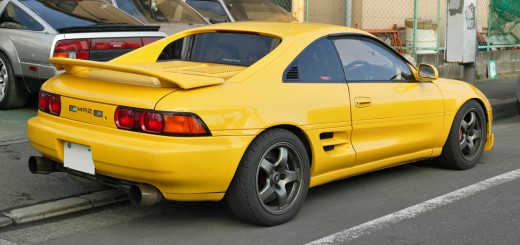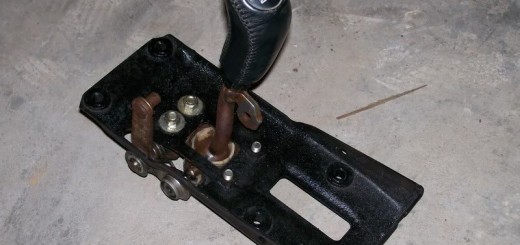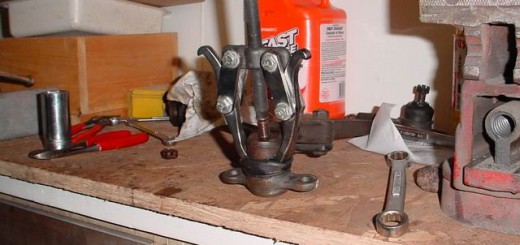Since I plan to run some quicker times this year, I thought it would be a good idea to pick up a set of Axle upgrade parts from ATS Racing. Axle breaks are common on MKII’s with good traction making above 300rwhp. I decided to do the install without pulling the full axles out of the tranny as the BGB tells you to do. Done that before, and it isn’t always fun putting them back in, plus I didn’t want to drain the tranny fluid…
I bought a box of latex gloves (necessity on this one!), CV Joint grease, and lots of paper towels. To pull apart the CV Joint, I also had to pick up this 8mm “disc brake caliper socket” from Autozone.

Main match mark, very important, go all the way across the joint, I used whiteout. I also put match marks on each of the washer/clips and cv joint so everything went back exactly as it came off. You’ll see those marks later.

First thing to do is to break all of the CV Joint bolts loose. I found a good angle to work with, and broke one free, then I took off the parking brake, and rotated the joint to get the next one. Do not remove them all the way yet, just get them loose. It took quite a bit of elbow grease.

Here is a shot of the passenger side joint.

Next, the wheel bearing lock nut cotter pin and cap…


32mm hardened socket…

Breaker bar and support so the socket doesn’t slip off. I also used a cheater pipe over the breaker bar for more leverage.

I pull the nut most of the way off, then use a piece of wood and hammer on it to push the axle back through the carrier. This can be a pain if they haven’t been off recently, but mine popped through like butter because I had done this about 5,000 miles ago.

I was also changing the rear brake pads, so here’s some shots of me taking the brakes off.


Tie rod end…

Disconnecting the lower arm from the axle carrier.

Taking out the 2 crash bolts from the knuckle…

Passenger side coming out now…

Mud bomb!

Time to get to work. Get a clean area setup first, and I suggest having a box of latex gloves ready, a cup of gasoline, and some rags/towels. Take pictures of the dissasembly if possible. Clean the grease off to get a good view. When it’s time to pull the inner race out, set it down face first, and pay attention to the side profile. It looked to me that once side is shorter than the other, so I made sure to reassemble the ATS parts in the same way. It could have been my imagination, but better to be safe than sorry.

Pry the boot clamp off with a flathead screwdriver, don’t damage the boot! (Ignore the grease here, these pics were taken on reassembly).


Once the clip is off, remove the CV Joint assembly as a complete unit.

Using snap ring pliers, pull the ring off of the end of the axle, and remove the inner race, cage, and bearings.


Pull the CV Joint out of the boot, and lay them both down carefully.

Old parts removed. I was real smart, and didn’t take pictures of the CV Joint still assembled, this caused me a headache later…

Here are the ATS upgrade parts…



Assemble the inner race, cage, and bearings. I tried to put duct tape on the CV Housing on the left to minimize on dirt and grease cross contamination, but it wasn’t really that helpful.

The trick for me was to place the housing above the race/cage/bearings, and put a little pressure on them from above, then lift them up, and push the inner race up an inch or two, this puts a little slack in the bearings, and the assembly will pop in. It takes some time, and at first didn’t seem like it would work, but it did.

Here is one of my first attempts. This is an incorrect install. The red and yellow marks should line up. It’s hard to explain, but here goes… The inner race has 3 long sides and 3 short sides, same thing for the outer race. The inner race short sides should line up with the outer race long sides, and tje ommer race long sides should line up with the outer race short sides.

Here is a correct install. The inner race and cage should be able to move freely when installed. Taking these pictures was actually a dangerous decision because the cage wanted to slide down out of my hand and drop the bearings, which would have forced me to start all over. I lucked out.


Time to put the CV Joint back on. First fill the boot half way up with a compatible CV Joint Grease.

Here is the ring going back on.

Cleaning the housing (use gasoline on all of the cleaning).

Cleaning the other half.

Cleaning the bolt holes.

Put some more CV grease in there.

Putting them back together. Lined up the match marks. Can’t tighten them until the brakes are back on.



Pull/push the axle end through the carrier.

Bolt up the lower arm.

Here I have loosely installed all of the bolts. Tie rod on the left, top crash bots, and bottom lower are bolts.

Put the brakes and disc back on, and then tighten down the CV Joint bolts one at a time with the help of the parking brake.

Tighten everything down, double check, cleanup, and you’re done.
This documentation in no way replaces the Toyota MR2 Repair Manuals. The purpose of this content is only to provide supplementary information to fellow MR2 enthusiasts. Midship Runabout and its contributing authors will not be held responsible for any injury or damages that may occur as the result of practicing any of the methods or procedures described within this website. Article and photo submissions are property of the contributing author.


